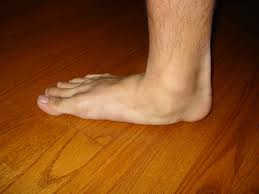Flat feet
What is a flat foot?
When standing, most people’s feet have a gap where the inner part of the foot (the arch) is raised off the ground. The height of this arch varies from person to person. If, however, your feet have a low arch or no arch at all, this is referred to as flat feet or fallen arches. When a patient with flat feet stands, their inner foot or arch flattens and the foot may roll over (hyper-pronate) to the inner side. Most people with flat feet never have any trouble and there is no need to consult a doctor about them. However in a few cases this condition causes pain, not only in the feet, but also in the legs and hips as they are out of alignment. In addition flat feet can cause bunions, calluses, plantar fasciitis (see Hindfoot conditions), tendonitis or stress fractures.
What causes it?
We are all born with flat feet, with the arches developing over the first few years of life. However, if flat feet develop later in life, this can happen as a result of an injury to the foot ligaments or tendons, arthritis, excessive weight gain, or during pregnancy. Some diseases of the nervous or muscle systems can also cause flat feet, or they may be hereditary.
How does it feel?
You will have pain in the arch of your foot and on the inside of your ankle, and sometimes in the lower legs and back. Your foot may feel stiff, or as if it is ‘rolling’ inwards as you walk.
Diagnosis
Your doctor will be able to diagnose flat feet by looking at your feet and the way you walk and stand, although he may ask you for an X-ray, sonography or an MRI (magnetic resonance imaging) scan to check for damage to the bones or tendons.
Treatment – conservative
In children, flat feet can be treated with exercises and special insoles (orthotics), and then the situation will be re-evalued in adolescence. In adults, the doctor may prescribe special insoles to lift the arch of your foot and/or stop your foot pronating (rolling inwards), and if you are overweight, you may need to reduce your weight.
Treatment – surgical
– Endorthesis: this is a simple procedure for correcting flat feet in children (between 8-12 years). Your surgeon will make a small incision on the outside of your foot, near the ankle. A small absorbable screw will be inserted into the synovial tunnel, which automatically makes your heel rotate inwards, lifting the arch.
– Calcaneus osteotomy: this procedure is normally performed in adult patients. Your surgeon will make an incision on the outside of your heel. He will then cut the calcaneus (heel) bone and move it inwards so that the inside of the foot rises to from an arch. Then the cut pieces of bone will be held in place with screws.
Rehabilitation after surgery
– Endorthesis: you will need to wear a cast to protect your foot for about a week. Once it is removed you will be able to walk normally, although it is normal to have some discomfort for 15-20 days afterwards.
– Osteotomy: you will be in a cast for about 3 weeks, and you will need to keep weight off your foot, using crutches, for 45 days after the operation. Then you will need to follow a physiotherapy programme to rebuild the leg muscles.
When will I be back to normal?
– Endorthesis: you should be able to return to normal sporting activity after a month
– Calcaneus osteotomy: you can return to office work after a week, but manual workers will need to wait between 6-8 weeks before going back to work. You should be able to drive and do light sports (cycling, swimming etc.) after 6 weeks, although you should wait a further 6 weeks before re-starting strenuous weight-bearing sports.
